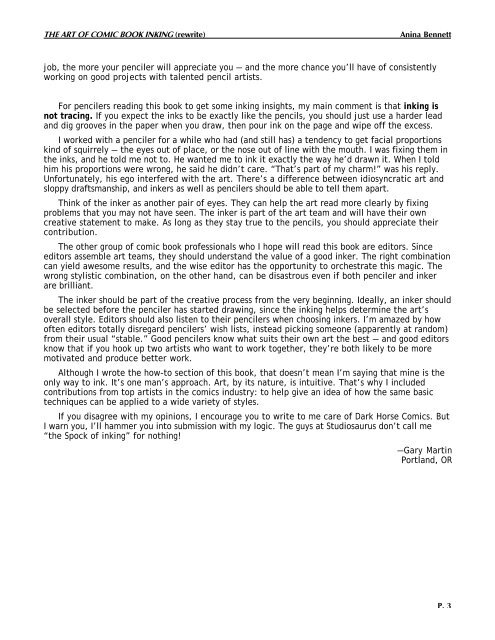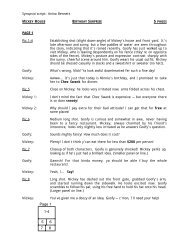THE ART OF COMIC BOOK INKING By GARY MARTIN (Rewrite by ...
THE ART OF COMIC BOOK INKING By GARY MARTIN (Rewrite by ...
THE ART OF COMIC BOOK INKING By GARY MARTIN (Rewrite by ...
You also want an ePaper? Increase the reach of your titles
YUMPU automatically turns print PDFs into web optimized ePapers that Google loves.
<strong>THE</strong> <strong>ART</strong> <strong>OF</strong> <strong>COMIC</strong> <strong>BOOK</strong> <strong>INKING</strong> (rewrite) Anina Bennett<br />
job, the more your penciler will appreciate you — and the more chance you’ll have of consistently<br />
working on good projects with talented pencil artists.<br />
For pencilers reading this book to get some inking insights, my main comment is that inking is<br />
not tracing. If you expect the inks to be exactly like the pencils, you should just use a harder lead<br />
and dig grooves in the paper when you draw, then pour ink on the page and wipe off the excess.<br />
I worked with a penciler for a while who had (and still has) a tendency to get facial proportions<br />
kind of squirrely — the eyes out of place, or the nose out of line with the mouth. I was fixing them in<br />
the inks, and he told me not to. He wanted me to ink it exactly the way he’d drawn it. When I told<br />
him his proportions were wrong, he said he didn’t care. “That’s part of my charm!” was his reply.<br />
Unfortunately, his ego interfered with the art. There’s a difference between idiosyncratic art and<br />
sloppy draftsmanship, and inkers as well as pencilers should be able to tell them apart.<br />
Think of the inker as another pair of eyes. They can help the art read more clearly <strong>by</strong> fixing<br />
problems that you may not have seen. The inker is part of the art team and will have their own<br />
creative statement to make. As long as they stay true to the pencils, you should appreciate their<br />
contribution.<br />
The other group of comic book professionals who I hope will read this book are editors. Since<br />
editors assemble art teams, they should understand the value of a good inker. The right combination<br />
can yield awesome results, and the wise editor has the opportunity to orchestrate this magic. The<br />
wrong stylistic combination, on the other hand, can be disastrous even if both penciler and inker<br />
are brilliant.<br />
The inker should be part of the creative process from the very beginning. Ideally, an inker should<br />
be selected before the penciler has started drawing, since the inking helps determine the art’s<br />
overall style. Editors should also listen to their pencilers when choosing inkers. I’m amazed <strong>by</strong> how<br />
often editors totally disregard pencilers’ wish lists, instead picking someone (apparently at random)<br />
from their usual “stable.” Good pencilers know what suits their own art the best — and good editors<br />
know that if you hook up two artists who want to work together, they’re both likely to be more<br />
motivated and produce better work.<br />
Although I wrote the how-to section of this book, that doesn’t mean I’m saying that mine is the<br />
only way to ink. It’s one man’s approach. Art, <strong>by</strong> its nature, is intuitive. That’s why I included<br />
contributions from top artists in the comics industry: to help give an idea of how the same basic<br />
techniques can be applied to a wide variety of styles.<br />
If you disagree with my opinions, I encourage you to write to me care of Dark Horse Comics. But<br />
I warn you, I’ll hammer you into submission with my logic. The guys at Studiosaurus don’t call me<br />
“the Spock of inking” for nothing!<br />
—Gary Martin<br />
Portland, OR<br />
P. 3



